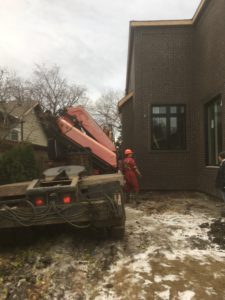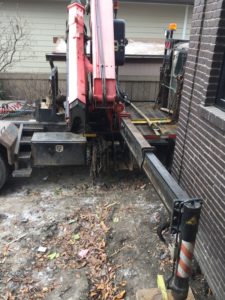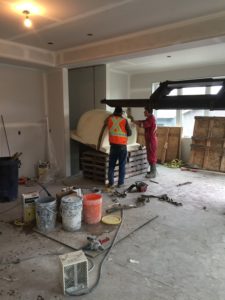We installed a pizza oven…a big one…in the kitchen of a residence. There are many pictures here, ours and the homeowners; please follow along as we plug them in.
The oven was 3000 lbs and had to be lifted onto a 4 ft high counter slot in the back of the room. It was already in the room, but the floor could barely hold its weight, and we couldn’t get a mini crane, or really anything else, in there. You can always use the Egyptian method, jack and block and skid, but it’s sweaty, labour-intensive and expensive. We looked for an alternative.

There was a clear line of sight from outside, through the patio door, to the install point, but the final placement was up high, about 4 ft, and the oven was another 4 ft itself. I looked outside the window. There was room for a truck outside if I jammed it against the bushes and the fence. The place was a construction mess (sorry bushes).

If we managed to wiggle out of the alley, we could squeeze by the garage and nose past the window, move a pile of garbage, or two and stick the tip of our crane right through the open patio door. I stood outside near the fence; it looked like a straight shot through the window, directly to the opposite wall. But it was a long way; 18 ft from window to the install point; too long, and too heavy for our little cranes, and that was the start of our problems.
Our knuckles articulate up, so if the windows were high enough, and the cranes low enough, we could reach in and angle up. If that worked, as we boomed out through the room, we would be gaining height the entire way. This is what’s known as wishful thinking.
The window looked high, and the ground sloped down outside, but the crane would be about 12-13 ft tall to start. Even if I brought the lowest shortest one we had, it would be close.
We have some smaller, feisty little cranes, and they could lift this pizza package, but they couldn’t send it across the room. We had to be able to handle the load, not just lift and pray like Hell.
Head scratching time
So, we needed about a medium size crane; an 18 ton would be good. We have one built especially for this type of situation; as low as we could get it, with a short wheelbase, and a custom dead stick. This pull out dead stick has a finger of steel projecting out from the top of the beam; match that with special pick up swivels and we save 2-3 ft of headroom before we even start. But for this lift, we would need it all.
I hoped the ground sloped down enough to give us some extra height, but we couldn’t be sure, our measurements looked very close.
We checked with the client, arranged to have the construction pile moved and collected a few more small slings. The initial lift would be fine, but the final placement on top of the concrete blocks could be tough to get the slings out. So, the one-inch slings seemed to be perfect; narrow but strong, and a couple of different lengths to ensure we could rig, tight and tighter.
We checked that we had sufficient shackles in the toolboxes and some small lift chains that are also an Encore Trucking idea. Just a piece of chain, with a small hook, but a certified lift device; just the thing for that last rigging adjustment, when you cannot allow any slack or stretch in the rigging.
We put the job off a week while we cleared our jack and roll crews out of the U of A.
As the date loomed, I put myself on the job as there were too many unknowns. For example, the small rollers we might need for the final positioning. Once it was set on the blocking, we would surely have to roll or pry or skid it into the final position against the back wall.
It was a chilly October morning when my rigger, Aaron, and I set out. We had spreader bars, extra slings, and we had phoned the client the previous night to let him know we were on schedule.
The house was in a great old neighborhood, with large trees and classy houses. Ours was a brand new brown brick two-story, a great looking place.
The streets were adequate, but anyone parking on them is a problem for the big units, and small as it was, old 314, the tandem Mack, was in tight quarters. We wanted to ‘drive’ into the lot, which meant we had to back into the alley, and dodge a couple of power poles and neighboring fences and garages. We pulled up and walked into the alley to check our route. That alley looked smaller and narrower every step we took.
We were hoping to use the neighbor’s two-car garage pad, cross the alley to sneak the back end of the truck around, and then drive forward into the lot. But his car was sitting there, running. Oh well, we could try it without using the pad, but the alley was 18 ft wide, that’s pretty normal, and the truck was 30 ft exactly.
We couldn’t even get directly into the alley, so we drove across the avenue into another alley and backed up into ours. The guy was coming out in the car. We backed out to let him pass and got out to talk to him. He had a look that said, “I’m in a hurry!” He didn’t want us using the driveway. “Okay, but it wasn’t new, it was already cracked, and the ground was frozen.” He didn’t care; the owner might object. “This truck is not that heavy.” He’d already had concrete trucks there, and he didn’t like that. “But, there were no new cracks?”
“No, not yet. Alright, go ahead.”
“Okay, thanks. See you later.”
We were quite a bit lighter than a concrete truck, but just to be sure, we pulled some plywood over to protect the concrete and spread out the footprint.
Begin maneuvering
The old Macks aren’t the tightest turning units, but we wrestled her back into the driveway. We had to use the entire thing to get the proper angle, but we managed to slip by the fence, down the side of the garage and into the back yard.

The first pile of garbage had been moved, but they had merely shuffled it onto the second pile, further down the side of the house. To shoot that crane through the door, we had to get the nose of the truck 14 ft past the window. The second pile had to be moved.
The General was there and said he could get it moved in a couple of days or later that day. We were there to work. It was a sizable pile; there were 3 of us, we flew at it and moved the entire pile in 15 minutes.

We squeezed over, crushing a few bushes, spared a tree, and were so close to the fence I had trouble climbing out of the truck. We checked the angle of the window and adjusted forward another 6 inches, then set up the crane as best we could. The front pad went down like a squished gopher; we added another and leveled everything out.


Aaron and I pulled the crane out and lifted the main boom as high as it would go. Then we tried the jib. It angles up 15 degrees, and if we were lucky, we would slide it through the window, and as we extended, the jib would build on that angle and gain height.

The oven was sitting on a beefy wooden pallet, about half of it visible through the patio door. We needed to drag it over and lift it off the pallet. We tried to bar the thing over by hand, but the little beast wouldn’t budge. Man, she was hefty!
How to rig?
We slide our little once inch slings under the pallet (thank the Lord for long fingers and tiny wrists) and got a grip on it. The picker has a remote control, so we were standing right beside the lift, watching and feeling the oven as it slid over. We only needed the center in view; once we grabbed it there, the rest would follow.
There was a plastic cap on a top chimney extrusion, right in the center front of the oven. We took it off, and the concrete extended 6-8 inches above the oven. That was bad news; we couldn’t afford to give up a single inch on this type of lift.
The General was looking nervous and told us the owner had built the entire house around this oven. He was an Italian guy and had a similar thing in his previous house only outside, so this was new and ‘special.’
“Oh boy.”
We re-rigged, this time to the oven, more wrist scraping, and lifted the tan-coloured oval off the pallet. Then we set one end on some blocking and did a final rigging tight this time. We lifted the little beast off the floor and raised the jib as high as we could, but, we were too low. The boom coming through the window was touching the frame.
We extended and moved the oven close to the end wall, but we were at least a foot short — crane too high, window too low. Then we had to find another foot of lift…somewhere.

We changed the slings around and added the chains to take up any slack, and gained a couple of inches. Then we decided to rig from the top of the boom tip, and shackle it there to prevent any slippage, we were basically tying the oven to the jib. We gained a couple of inches, but the one-inch slings were working hard, and they were stretching. We re-rigged to wider slings, and gained another inch, barely.

Every time we lifted the oven, we blocked it up with a stack of pallets we’d found in the garage. We needed 4 ft of double wide stacks, almost 20 pallets, hauling them from the garage and shoving them through the windows.
There was another problem. The farther we reached in through the door, the more cylinders crept forward, and they are banked up high, so the final few ft of reach brought a 6-inch high cylinder under the window header.
If we set down and pushed the dead stick back a couple of feet (there are multiple settings), we could let the barrel of that cylinder come right inside the room and gain a few more precious inches; before the next one hit.
So, we re-rigged and slid the extension back. It was heavy, but we gained a couple more inches. And we tried again. We didn’t make it, but we were within a couple of inches.
We decided to try one sling, right in the middle to see what or if we gained. It helped a little, but not enough. Of course, we were 2 inches too low overall.
A new idea came to us. We blocked the oven as high as we could and moved the sling to let the oven sit at enough of an angle, hopefully allowing the far end to tip above the block wall base.
We lifted, and just as we touched the top of the window, Aaron pulled down hard on the near end; and we cleared the wall. We shot out the boom slowly and went to set the oven on our pipe rollers. None of them would fit. We searched high and low, through the garbage, and finally, I snapped the truck’s push boom handle into four pieces and shoved them under. We braced our one end and let the little beast down.

It held, and we removed our big sling, came back to the one end; now, we had room and could lift from a lower base point. We put the one-inch slings back on.
Now we had to try to push the oven straight back with walls about one inch away on both sides. Our boom wasn’t at the right angle. We were pushing crooked. We tried to pry on the oven, but the weight was too much. Then we had to move the crane.
We pulled our rigging and scoped back through the window, set the crane gently over the rear, pulled the legs and backed up another 6 inches.
Almost done
We reset the crane, scoped back in and worked on the sliding. It fought us, and we put a 2”x10” against the oven wall but didn’t want to push too hard, but it ‘was’ concrete. There was an opening under the oven. I crawled in underneath and bared as best as I could, lifting and squeezing the little bars in but the weight crushed my wooden handles and collapsed the plastic pipe.

Somehow, in the end, we managed to wrestle the oven monster to a spot the General liked. We jerked the slings out, checked around for gear, snuck out of the backyard, made it out of the alley, and headed for home base.

It felt good, but when we walked back into the office, we asked if there was any blood visible on us.
It takes a lot of gear, a lot of experience and a lot of planning to do one of ‘those’ jobs, even the smaller ones.
Encore is ready. We hope this tough little story shows that.
